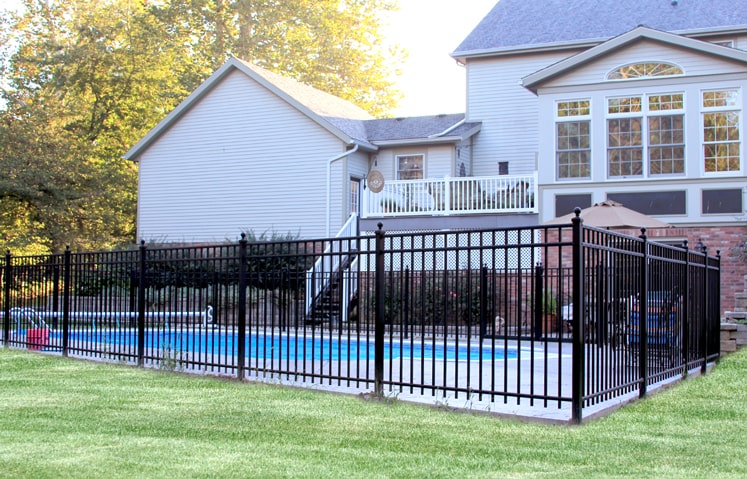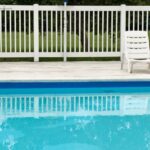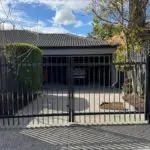
Pool fences symbolize joy, relaxation and a refreshing escape from the heat. However, pools can be hazardous, particularly for young children. Every year, tragic accidents occur and lives are forever changed due to drowning incidents, with children under the age of five being especially vulnerable.
Understanding the gravity of this issue underscores the utmost importance of implementing effective safety measures. Among these measures, the installation of pool fences emerges as a crucial factor in preventing accidents and safeguarding lives. A pool fence serves as a physical barrier that acts as a first line of defense, preventing unsupervised access to the pool area and reducing the risk of drowning incidents.
Read more: 7 Crucial Areas for Installing a Fence in Your Home
What Is a Pool Fence?
A pool fence serves as a protective enclosure surrounding a swimming pool, designed to create a passive barrier that limits the access of young children to the pool area. Its primary purpose is to prevent accidental drowning, a tragic cause of death for children worldwide. By acting as a physical barrier, the pool fence restricts entry to the pool area, minimizing the risk of unsupervised access. This safety measure is particularly crucial for young children who may not possess the necessary swimming skills and awareness of water safety.
Benefits of Pool Fences
Prevention of accidental drowning
A pool fence serves as a crucial safety measure, significantly reducing the risk of accidental drownings, especially among young children.
Restriction of access to the pool area
The physical barrier created by a pool fence prevents unauthorized entry to the pool, ensuring that young children cannot wander near the pool unsupervised.
Barrier for young children
Pool fences are designed to be difficult for young children to climb over or crawl under, providing an additional layer of protection against accidental drowning.
Compliance with legal requirements and regulations
Many jurisdictions have specific safety codes mandating the installation of pool fences. By adhering to these regulations, homeowners can avoid penalties and legal liabilities.
Reduction of legal liabilities
By having a pool fence in place, homeowners minimize the risk of accidents or drownings in their pool, thereby reducing potential legal responsibilities.
Enhancement of overall pool safety
Pool fences limit unsupervised access to the pool, ensuring that individuals, particularly children and non-swimmers, cannot enter the pool area without adult supervision.
Decrease in accidents and injuries
The presence of a pool fence significantly reduces the likelihood of accidents such as falls into the pool or slips on wet surfaces around the pool.
Peace of mind for parents and guardians
Knowing that their children cannot access the pool area without supervision, parents and guardians can relax and enjoy their time by the pool without constant worry.
Alleviation of anxiety related to pool safety
Pool fences create a physical barrier that adds an extra layer of protection, easing concerns and reducing anxiety for parents regarding their children’s safety around water.
By installing a pool fence, individuals can prevent accidents, comply with regulations, enhance overall pool safety and experience peace of mind. These advantages highlight the importance and effectiveness of pool fences in creating a safer environment for pool users and those living in close proximity to pools.
Drawbacks of Pool Fences
Cost implications
Initial installation expenses: The installation of a pool fence can be costly, particularly if professional installation or customization is required to accommodate specific pool layouts or landscaping features. Maintenance and repair costs: Over time, pool fences may necessitate maintenance, such as painting or replacing damaged sections, which can add to the overall cost.
Aesthetics and visual appeal
Impact on the overall pool design: Some pool owners may find that a fence disrupts the desired visual aesthetics of their pool area, as it can obstruct the view of the pool and surrounding landscape. Potential obstruction of views: Depending on the fence design, it may limit the view of the pool, which could be undesirable for those who prefer an open and unobstructed visual experience.
Limited accessibility
A fence may require individuals to pass through a gate or remove a safety latch to access the pool, which can be seen as an inconvenience, especially for frequent pool users. The presence of a fence can restrict free movement around the pool area, potentially affecting social interactions or activities such as sunbathing or pool games.
It is important to acknowledge these drawbacks when considering a pool fence, as they can impact the cost, design and overall experience of using the pool area. However, it is worth noting that many of these concerns can be mitigated through careful planning, alternative designs and regular maintenance. By finding a balance between safety, aesthetics and usability, individuals can address these drawbacks effectively.
Consider Some Factor to Choose a Pool Fence
When choosing a pool fence, there are several factors to consider:
Material
Select a material that suits your preferences, budget and maintenance requirements. Common options include aluminum, vinyl, wood and mesh. Each material has its own advantages in terms of durability, aesthetics and maintenance needs.
Height and Design
Ensure that the fence is at least four feet tall to prevent easy access by young children. The design should have smooth surfaces without horizontal bars or footholds that could facilitate climbing. The gate should open outward from the pool area and have a self-closing, self-latching mechanism for added safety.
Visibility
Balancing safety and aesthetics, choose a fence design that allows for unobstructed views of the pool and surrounding area. Clear or mesh panels offer transparency while maintaining the necessary safety barrier.
Installation and Maintenance
Consider hiring a professional for proper installation to ensure compliance with local regulations. Regular maintenance is important for keeping the fence in good condition. This includes inspections for damage, cleaning to remove dirt and debris and lubricating gate hinges and latches for smooth operation.
By carefully considering these factors, you can select a fence that provides optimal safety, meets your aesthetic preferences and requires manageable maintenance. Remember to also adhere to any local regulations regarding pool fence requirements.
Conclusion
Installing a pool fence offers numerous benefits and is an essential safety measure for any pool owner. It helps prevent accidental drownings, restricts access to the pool area and complies with legal requirements and regulations. By enhancing overall pool safety, providing peace of mind for parents and reducing potential liabilities, a fence is a crucial investment. Consider factors such as material, height and design, visibility and proper installation and maintenance. Finding the right balance between safety, aesthetics and functionality will ensure a secure and enjoyable pool environment for all. Contact us to know more about our fences services.





